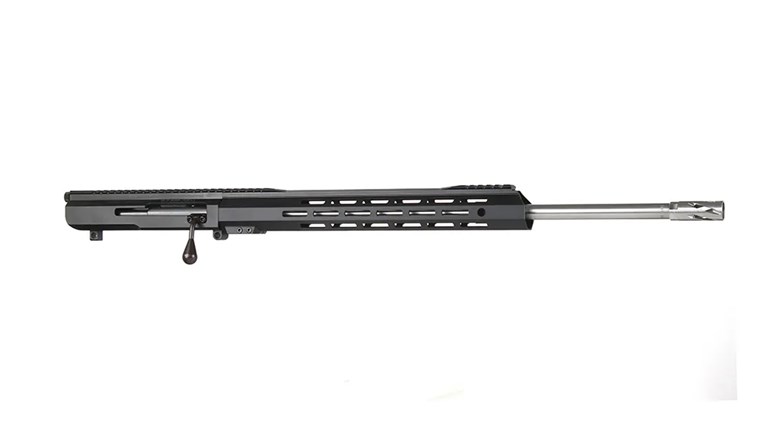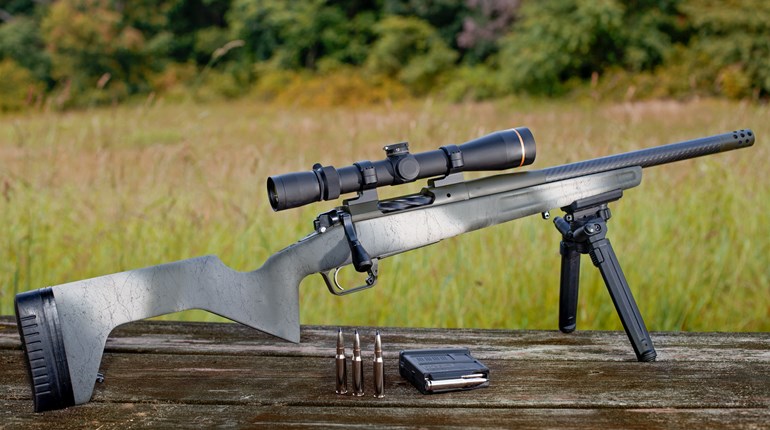
While the name Smith & Wesson may conjure images of big wheelguns or the pugnacious guy at a frat party's fists, the renowned gunmaker has enhanced its reputation of late via its M&P line of semi-automatic handguns and AR-platform rifles. These more modern firearms have earned accolades among shooters looking for practical self-defense guns and competitive shooters alike, thanks to the Springfield, MA-based company's ergonomic and affordable pistols and quality ARs at a similarly reasonable price.
The M&P15 line of ARs is extensive. Whether you're looking for a quad-rail fore-end, Magpul furniture or even a California-compliant version, the 18 rifles and carbines in Smith & Wesson's lineup are likely to meet your needs. But, until now, we have been limited in terms of chambering selection to 5.56 NATO. Thanks to the M&P10—introduced in 2013—those seeking more punch from their AR now have a .308 Win./7.62 NATO option from a trusted manufacturer, and an affordable, quality choice at that.
Weighing less than 8 pounds, the M&P10 is substantially lighter than many 5.56 NATO ARs, yet sturdy enough to handle the larger, more powerful .308 Win. This light weight comes despite an additional 2 inches of barrel length. Why an 18-inch barrel? Smith & Wesson Director of Marketing and Communications Paul Pluff explained that the company was looking for an "in-between" barrel length. A precision shooter might prefer a 20- or 24-inch barrel, while someone looking for a "tactical" carbine would likely choose a 16-inch pipe. "Ultimately, for our first .308 Win. AR, we had to pick a barrel length," Pluff said. "So, we chose a length between the two extremes. The result has a minimal effect on performance at longer ranges, yet still allows the M&P10 to be maneuverable in close quarters."
I can attest to both the performance and maneuverability qualities of the M&P10, as I used one of the first production models on a hunt in Oklahoma. Sitting in a confined box blind, I was able to move the rifle from front to side windows without slamming it against the steel walls and alerting every critter for miles to my presence. When a running sow came charging in my general direction, it was quite easy to change shooting positions for a shot, and when I squeezed the trigger, I was quite pleased to have .308 Win. power. Even at a mere 25 yards, a single 5.56 NATO round seldom drops a feral hog on the spot, but the 250-pound pig could not withstand my well-placed shot from the M&P10 and hit the ground immediately.

At the other end of the spectrum, the M&P10 delivered consistent 2.5- to 4-inch groups at 250 yards on paper, despite a constant crossing breeze of between 5 and 10 mph. Would a longer barrel produce tighter groups? Perhaps. Would I have had even greater maneuverability with a 16-inch barrel? Possibly. Did either of these factors matter in real life? No. I think the trade-offs from Smith & Wesson's choice of an 18-inch barrel are generally positive for the M&P10, particularly when one takes a holistic view of the rifle.
Starting at the muzzle, Smith & Wesson innovates right off the bat with a patent-pending Enhanced Flash Hider (EFH). This device threads onto the light-contour barrel and is slightly longer than a standard A2 model. In addition to a crenulated face—which can double as a glass-breaker or a "chest-tapper"—the rear of the EFH has holes facing forward. These holes vent gas outward and to the front, which, in my experience, had no effect on felt recoil, but seemed to keep muzzle rise to a minimum. Also, because gas is vented away from the shooter, you are much less likely to have unburned powder or debris blown back into your face than with a standard muzzle brake or flash hider.

The 4140 steel barrel has a corrosion-resistant finish and tapers to a light contour in front of the gas block, and then back out prior to the EFH in order to accommodate most muzzle devices. A mid-length gas system starts at the machined, low-profile gas block, which has a rail section at 12-o'clock for mounting an aftermarket front sight. Smith & Wesson chose wisely with the mid-length gas system for two reasons. First, while a full-length gas system would not add much weight itself, the resultant need for longer handguards could potentially add significant heft to a rifle intended to be relatively lightweight. Second, carbine-length gas systems simply are not as reliable as longer options in the AR platform because the gas used to run the action is tapped closer to the chamber, and is therefore considerably hotter. The hot gas can cause wear on the bolt carrier and eventually lead to stoppages. A mid-length gas system mitigates this concern without adding unwanted bulk to the rifle—again an intelligent compromise well-suited for the M&P10's intended role as an all-around firearm.
Standard, A2-style handguards provide a standard platform to grip the rifle, but are obviously not ideal. They do, however, keep the M&P10's price down, which is nice, and they can be replaced with a large number of aftermarket options with or without rails. At the front of the magazine well, Smith & Wesson machines serrations into the lower receiver. These serrations provide added purchase when the shooter makes use of a close grip with the support hand, and I found them helpful when utilizing such a grip while traversing the rifle on a makeshift rest in the field.
The rest of the lower receiver is where things start to get quite interesting. A bowed trigger guard enlarges the area inside, making it easier to shoot when wearing gloves. Many AR enthusiasts will purchase an aftermarket trigger guard to achieve this added space, but it comes standard on the M&P10. The magazine release, bolt release and safety-selector levers are all ambidextrous, so operation with either hand is a cinch. The safety selector has both a long and a short paddle and is reversible, depending on your preference, but can be actuated from either side—you might call it "extra-ambidextrous."

Inside the M&P10, Smith & Wesson spared no expense. The bolt carrier, gas key and firing pin are all chromed, and the bolt itself is machined from 9310 steel. With such construction and attention to detail, the rifle is as tough as they come and will take a fair amount of abuse. If one looks at the firing pin as though it was a sword, just in front of the "guard" one will find a spring surrounding the lower portion of the "blade." This spring serves an important function. Lightweight firing pins can (though rarely do) rebound under recoil with enough energy to strike the primer on the next round loaded into the chamber, causing an unintended, and therefore potentially dangerous, discharge. The firing-pin spring in the M&P10 ensures the unit will not rebound, eliminating any chance of this unlikely occurrence.
The upper receiver is a flattop model, with Picatinny rail on its upper portion for mounting optics. Given this is a .308 Win. AR, most shooters will want to mount a magnified scope for longer-range use, so the decision to ship the M&P10 without sights makes a lot of sense—and helps keep the price relatively low, too. I had no problem shooting the rifle with a Bushnell hunting scope or using a Trijicon ACOG, so those who prefer a more "tactical" optic needn't worry. That said, a traditional-style, magnified riflescope is, in my opinion, the better choice for a rifle that seems to be perfect for the designated-marksman role.
Both the grip and six-position, collapsible stock are generic models and are easily replaced should you seek something fancier. I might consider a different stock with a recoil pad, because while the M&P10's recoil is certainly manageable, it is significantly more powerful than that of a 5.56 NATO AR, for which the generic stock style was originally designed.

As far as parts go, there is only one real negative, and it is the M&P10's magazine. For some reason, Smith & Wesson ships the rifle with a 10-round mag instead of a more sensible 20-round version. Fortunately, proper-size AR-10 magazines abound at retail, so you should have no difficulty getting a bigger mag if you live in a jurisdiction that respects the Second Amendment. Still, it would be nice if the M&P10 came with a standard-capacity magazine, and since most M&P15 models come with 30-round versions, I'm stumped as to why Smith & Wesson chose to ship a low-capacity option with the bigger gun.
At the range, the M&P10 digested three different loads with zero malfunctions and turned in respectable, sub-2-inch groups at 100 yards. Add those results to a buck at 150 yards, a doe at 175 yards and two pigs at close range, and the M&P10 proved reliable, accurate for multiple uses and able to handle nearly any chore. The two-stage trigger on my test rifle broke at just more than 6 pounds, but exhibited a touch of creep in the first stage. That said, it is right about average for an AR-platform rifle and did not hamper the gun's accuracy (I can take care of that on my own).

Since I had the opportunity to test the rifle both on a hunt and on a square range, my experience matches the intended purpose of the M&P10—it's an AR for everything. The performance of .308 Win. in combat, competition and on game is well documented, so I won't belabor the point here. I will, however, bring an observation from a source who knows what he's talking about.
Recently, I had the opportunity to shoot with and interview Medal of Honor recipient Sgt. Dakota Meyer (USMC, ret.). When I asked him if there was one piece of gear he wished he'd had in Afghanistan, he told me he would have loved a 7.62 NATO rifle as opposed to his issued 5.56 NATO M4, citing the former's reach and power.
While Sgt. Meyer was not speaking specifically of the M&P10, I think he would approve of the rifle. It makes for an easy transition for anyone familiar with the AR platform, yet it provides substantially more power than a 5.56 NATO firearm, all without adding much, if any, weight. The .308 Win.'s lauded versatility is matched perfectly by the M&P10's all-around performance capabilities, and yet the rifle is quite affordable for a large-receiver AR.
Ultimately, Smith & Wesson did more than merely check a box to fill a void in its M&P line—it created what might be the epitome of a utility rifle. If you're looking to up your AR's effective range or its power, you won't go wrong with an M&P10.
Specifications
Manufacturer: Smith & Wesson; (800) 331-0852
Action Type: Direct-gas-impingement, semi-automatic
Caliber: .308 Win./7.62 NATO
Capacity: 10 rounds
Receivers: Hard-anodized, 7075 T6 aluminum
Barrel Length: 18 inches
Rifling: 5 grooves; 1:10-inch RH twist; 5R rifling
Sights: None; railed receiver and gas block for mounting optics and/or iron sights
Trigger Pull Weight: 6.1 pounds
Stock: 6-position CAR
Length: 40.9 inches (extended); 37.6 inches (collapsed)
Weight: 7 pounds, 11 ounces
Accessories: 10-round magazine, manual
MSRP: $1,619
Shooting Results
| Load | Velocity | Group Size | ||
| Smallest | Largest | Average | ||
| Hornady 110-grain TAP-FPD | 2,915 | 1.05 | 1.87 | 1.42 |
| Federal Premium 150-grain Nosler Ballistic Tip | 2,697 | 1.08 | 1.91 | 1.39 |
| Black Hills 168-grain Match HP | 2,563 | 1.17 | 1.65 | 1.35 |
Velocity measured in fps at the muzzle for 10 consecutive shots with an Oehler Model 36 chronograph. Temperature: 72 degrees Fahrenheit. Accuracy measured in inches for five consecutive, five-shot groups at 100 yards from a Caldwell Handy Rest.





































